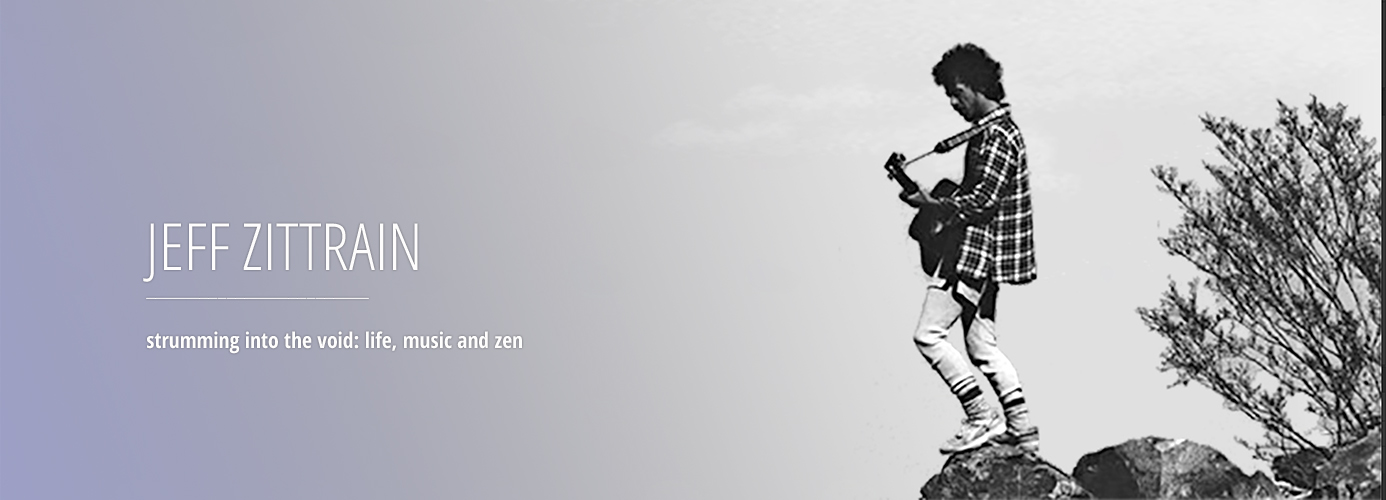
An insightful reader made the suggestion last month that perhaps this column should be renamed “Comin’ Around in a Circle.” That Dead chorus from “The Other One” seems to pop up in triumph like three oranges on a slot machine at the end of each column because they twist and wind and somehow circle around and connect, even when you don’t expect them to. I certainly don’t.
Well, actually, since it keeps happening I do expect it now. But I don’t plan how they will connect. I just trust that they will. I think it’s related to Swiss psychologist C.G. Jung’s concept of synchronicity – what he called the “acausal connecting principle” that “explains meaningful coincidences by suggesting a deeper underlying pattern.”
More importantly, it’s also the mysticism in the Dead philosophy which fuels their approach to improvising music. It’s about letting go in surrender to the muse, to just “relax and float downstream” as John Lennon put it in his musical adaptation of Timothy Leary’s psychedelic adaptation of the Tibetan Book of the Dead. This might cause some initial chaos, but the end result reveals a deeper pattern, a connection where everything is one.
“And the end of all our exploring will be to arrive where we started and know the place for the first time” T.S. Eliot said in his famous poem of spiritual transcendence, Four Quartets. Sounds to me like, for instance, “Playin’ in the Band” into “I Need a Miracle” into “Dear Mr. Fantasy” back into “Playin’ in the Band,” a classic Dead second set sequence I remember as “Playin’ in the Miracle Fantasy Band”. The Dead song morphing technique relies on the principle of synchronicity as songs and riffs reveal themselves in new ways as they spontaneously emerge, disappear, and re-emerge from the vast stew of the jam.
This all seems more relevant as the world speeds up and becomes less focused – at least that’s what seems to be happening to me. As I mentioned in my iPod column a while back, I don’t seem to listen to albums as wholes anymore, but just hear individual songs on shuffle. As with my iPod, so with the rest of our increasingly non-material digitized world. It’s like our whole culture is on “shuffle” mode.
And while this can seem at times to be crazy-making, there’s also a way to find the deeper underlying patterns. It’s really all we can do.
It’s the principle behind the Tarot and the I-Ching. The idea that the way the cards fall or the coins are tossed is not random but a part of the whole pattern of the universe – which we can learn to read.
According to Phil Lesh, the Dead used to play a game called “Radio I-Ching” where they’d randomly tune the radio and see how whatever was playing would fit whatever they were talking about at the time.
With this in mind, let’s look at the latest goods from my trip to the used dvd store, which I procured purely on the basis of what bargains I could find, with no preconceptions, patterns or prejudices in mind:
The Longest Yard (original Burt Reynolds film from 1974)
Bedazzled (Harold Ramis’ Brendan Fraser/Elizabeth Hurley remake from 2001)
The Exorcist III (made in 1990, I got it since it was only 1.95!)
The Thin Red Line (Terrence Malik’s 1998 version)
So, DVD I-Ching, here we go:
In The Longest Yard, the Burt Reynolds character has one final shot at redemption in prison – he learns to care about other people and sacrifices himself (20 more years in prison) just to give the other inmates some dignity.
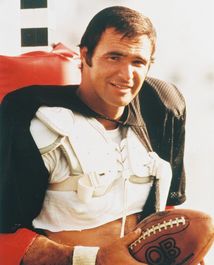
In Bedazzled, the Brendan Fraser character also redeems himself, also in jail (at the end) and also through self-sacrifice – when he relinquishes his final wish to care for someone else’s happiness – which voids his contract with the devil and lets him keep his soul.
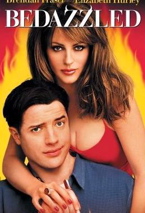
In Exorcist III, the devil also takes center stage, but looking nothing like Elizabeth Hurley, instead taking over the body of the priest from the first Exorcist film who (surprise) sacrificed himself to save Linda Blair – and (2 for 1) sacrifices himself again in the climax of this film, pleading to be shot and killed at the end.
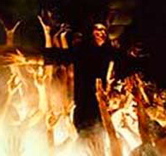
The Thin Red Line boasts a ridiculously large ensemble cast and not much plot, but the central character is a soldier played by Jim Caviezel, who – guess what – sacrifices himself at the end to save his platoon.
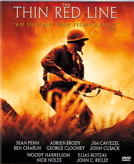
Caviezel, not coincidentally (nothing is in Jung’s world), would go on to learn a little more about self-sacrifice, of course, from his starring role in Mel Gibson’s feel-good religious snuff-film “Passion of the Christ.”
And maybe that’s what’s hanging over all of these films – they’re all connected under the rubric of self-sacrifice because they’re all products of a culture soaked in Christianity. (In fact “It’s a Wonderful Life”, that other cheery Christmas tale of self-sacrifice, also makes a none-too-subtle appearance in Exorcist III). They’re also all fairly mainstream, although The Thin Red Line adopts a pretty experimental approach, using internal monologues and poetic shots of nature so it seems at times like, as one critic put it, a cross between “Wings of Desire” and the Discovery Channel.
Mythologist Joseph Campbell would ascribe this phenomenon not to lame Hollywood formulas, but to Jungian archetypes, and the idea that there are only a few essential stories, which are told over and over again across cultures and through time dressed up in different names and customs.
Still, this is only four, fairly mainstream dvd’s. What if I had added another at random? Would just anything fit? How about a non-Hollywood dvd? Easy enough – how about the one that I had in my hand but left at the store for another day – Peter Gabriel’s “Growing Up On Tour.” It’s not Hollywood – it’s not even a story but a record of his concert tour – are there any connections with the other films?
Being that I left it at the store, I haven’t seen it which makes analysis more tricky…but Jung’s synchronicity encompasses all the connections implied in 6 degrees of separation…
So:
Peter Gabriel did the soundtrack for Martin Scorceses’ “The Last Temptation of Christ.” The Genesis magnum opus “Supper’s Ready” is taken in large part from the Book of Revelation. The Lamb lying down on Broadway, the title image from that other Genesis magnum opus, is certainly at some level an act of self-sacrifice. And Peter Gabriel used to offer himself up to the audience, with a ritualistic leap backwards into the crowd during “Lay Your Hands on Me.”

And as long as we’re finally back into the realm of music, let’s come around in a circle back to the Dead. You don’t have to be happy about your self-sacrifice. “Half of my life I spent doing time for some other fucker’s crime” laments August West in “Wharf Rat.” But that seems to be the human condition in our interconnected world. We’re all paying for everyone else’s sins.
August West is a Robert Hunter creation inhabited by Jerry Garcia. So let’s move out to the reality. I’ve read more than a few accounts of the Dead machine growing so big that Jerry literally could not stop touring, even when he wanted – or needed – to. Isn’t there a sacrifice in there?
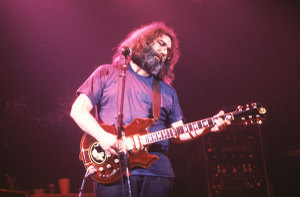
The German philosopher Friedrich Nietzsche articulated the concept of “Eternal Recurrence” where history is destined to simply repeat itself over and over. Sounds miserable in one way, but Nietzsche saw acceptance of this as an embrace of life. And to return to Harold Ramis, his “Groundhog Day” saw this concept in Hindu terms, where you can learn from the repetition and be released from the wheel of birth, death and rebirth. Something even deeper lies beneath the similarities. The Song Remains the Same.

The dvd’s I bought remain the same, also. That is, they were all remakes in one way or another. Exorcist III was a sequel, Bedazzled was originally a Dudley Moore film, The Longest Yard would be remade by Adam Sandler, and The Thin Red Line was the second film adaptation of the 1962 novel by James Jones.
The trick I guess, lies in learning from the pattern. The positive side of repetition. Not such a far-out concept, really. Musically speaking, groove is based on repetition. Hook into the same thing over and over. It feels good, you know that it would, now. The rhythm of the saints. We’ve all known that, from Robert Plant to James Brown to Paul Simon back to… Robert Plant:
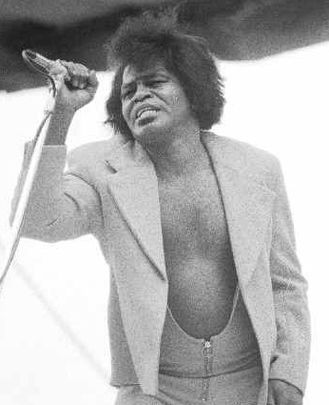
The song may remain the same, but everything that’s small has to grow – and it has to grow! Push, Push…

And that feels good, comin’(comin’), comin’(comin’), comin’ around…

13 RESPONSES TO “ COMIN’ AROUND IN A CIRCLE… ”
- # 1 Ruth Says: October 3rd, 2006 at 10:43 pm
- I’m just printing this out now…..then will let you know tonite how I liked the new column! Lovel, MOM
- # 2 Sal Says: October 4th, 2006 at 12:14 am
- Haha, your Mom posted! I think this one is a favorite. I especially like the ‘learn from the pattern’ bit that ties it all together neatly. When you think about it, people are just a bundle of idiosyncratic tics and habits. We do nothing but repeat patterns in our lives over and again if you think about it. Where’s the purpose in that kind of OCD life?
- I don’t know but a lot of us seem to find it anyhow; the pride of purpose going to work to do the same thing everyday, the joy of kissing the same woman every day for 50 years and so on.
- And that is what’s reflected in art, be it music, painting, film, etc. Everything is a repeating pattern and in a sense you could say that everything has been done before but if you live in the moment…
- I dunno…peace.
- # 3 Joe Says: October 4th, 2006 at 12:26 am
- Now that’s allright man. You used my column title idea. I can dig that.
- # 4 Rose Says: October 4th, 2006 at 12:32 am
- That’s so cute, your Mom posting. You’ll have to let us know if she liked it.
- Jungian archetypes are totally right and so was Campbell. Everything derives from the same set of originating myths. The flood can be found in ancient Babylonian, Sumerian and Jewish mythology. So it made its way into Christian mythology and now people think they can find an actual ark on a mountain in Turkey! Same goes for the creation story. Every culture the world over has a variation of the creation myth. And it goes on and on and on.
- So it goes without saying I think that the same happens in music and art. After all they are just extensions of a culture’s mythology in a way. Certainly what Jerry and the Dead accomplished and what they represent could be considered mythological.
- Think to what scholars will be saying about the worldwide “hippy” phenomenon and the role that Jerry Garcia played in it 100 years from now, 500. It will become another piece of an archetype that’s been growing since we started painting stick figures on caves.
- Thanks for reading and getting me thinking.
- # 5 Dave Terpeny Says: October 4th, 2006 at 12:53 pm
- Hey Jeff’s Mom, thanks for the Mean Joe Green autograph!!!! Very cool column Jeff, one of my favorites along with Shadows.
- And I agree with most of these comments. Everything, including mythology, repeats itself. But instead of seeing it as “everything’s been done before” I see it as a constant evolutionary process, a reinvention or building upon a foundation. I suppose my outlook is more Ramis than Nietchze. Haha.
- # 6 duckduckgoose Says: October 4th, 2006 at 4:24 pm
- Jerry felt he couldn’t stop touring because so many people relied on the Dead for their income. Like ol Jer himself the organization got bloated and filled up with too many hangers on, sucking them dry.
- But Jerry was a big boy and could have told them to stuff it if he wanted too. So why did he keep going, slowly killing himself? The Mind of Jerry would make a great psychology book.
- # 7 Jeff Says: October 5th, 2006 at 4:41 pm
- Thanks for all the comments – I guess my mom’s posting shows that “Right Action” is a family-column, despite all the psychedelic references and occasional sexual allusions….
- But “learning from the pattern” – that’s I guess the big key here…
- By the way, lest anyone think connecting Led Zeppelin and the Dead is a stretch, I saw Bob Weir and the Waybacks last night cover “Kashmir”…which was, admittedly, kind of a stretch…
- # 8 thembonez Says: October 6th, 2006 at 12:23 am
- So all of that to say that history repeats itself so watch out? Now that’s a stretch my friend. Isn’t it the pattern itslef that learns, outside of our feeble attempts at rationalization?
- Never heard of your band before. You sound tight. And your bassist is hot.
- # 9 Jeff Says: October 6th, 2006 at 3:52 am
- Never heard of Famous Last Words?! You must not be a Kynd regular…
- The pattern itself learns – that’s nice.
- And thanks for the props on the band…
- # 10 asaunders79 Says: October 12th, 2006 at 11:06 am
- damn this stuff is deep. what ever happened to turn on, tune in and drop out?
- # 11 Jeff Says: October 17th, 2006 at 2:55 am
- This is part of the “tuning in” part – check out Timothy Leary’s writings – that slogan meant getting deep to him…to me it’s the irony of the “deadhead” moniker – your “head’s all empty” on the one hand, but completely enlightened on the other…(and a head in two hands is worth one in the bush…hey now, no left turn unstoned…)
- # 12 Bridget Says: November 6th, 2006 at 7:38 pm
- Jeez Jeff – I feel like it’s 1987 and I just left your class. I mean that in a good way. My brain’s all workin’ now.
- # 13 Dave Terpeny Says: November 7th, 2006 at 1:32 am
- I don’t think is a Dead reference…more of a Rwandan folk saying that I heard today….it takes two hands to break the bone…the kind of spooky equivalent to two heads are better than one. Go figure. Totally unrelated. Yay.
